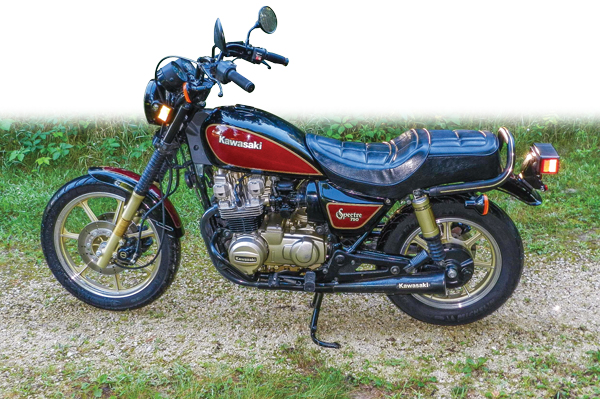
In 1982, this was the latest version of the well-known KZ750, its main differences being a fine paint job and a few other modifications. Gone was all of the bright, shiny stuff, with polished alloy and sparkly chrome conspicuously absent. Instead there was gold-striped red and black paint on the gas tank, fenders and side panels. The engine cases were covered with a protective gold-colored oxide layer, as were the seven-spoke cast wheels. Even the grab bar at the rear of the saddle kept up the golden look. Impressive, especially when cruising down Main Street around midnight, as it gave off a mildly dangerous image. Adding to the mystery were the black-chrome header pipes and short, megaphone style mufflers, providing an admittedly mild bark. This was the Spectre.
Looking up the word “spectre” (the British spelling of “specter”), the dictionary definition is: “ghost; something widely feared as a possible unpleasant or dangerous occurrence.” The early 1980s were a time of ominous names, harking to something dark, weaponized, prone to violence. Like Ninja, Katana, Nighthawk, and my favorite, Midnight Virago—which could mean either a bad-tempered woman or a female warrior. I did like the Spectre name, and Kawasaki briefly stuck it on the side panels of a 750 and 1100 (in ’83 a 550 was included) using in-line, air-cooled, carbureted four-cylinder engines—the essential UJM.
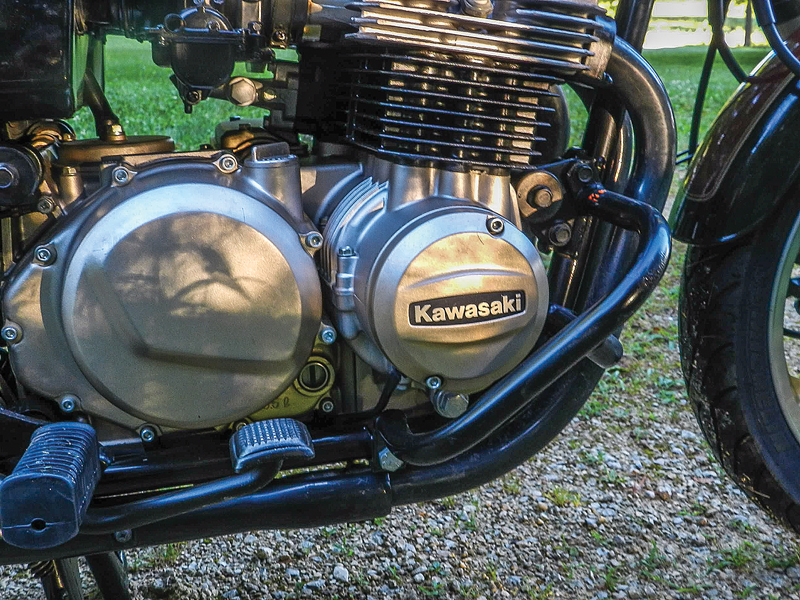
At the time, the Japanese were going after the “custom” market, having seen that many Americans were more interested in style than performance. It was a rather benign flanking maneuver, as most people appreciated that the owner, not the factory, created a true custom. But Kawasaki thought there would be a market for an OEM-built custom/cruiser. Its first effort at customizing was the LTD version of a 1976 KZ900, with cast wheels and a stepped saddle—that two-level saddle was seen as a key to cruiser styling. The sales were moderately successful, and in 1982 the Big K offered both a 750 LTD and the 750 Spectre—whose main selling point was mostly its paint.
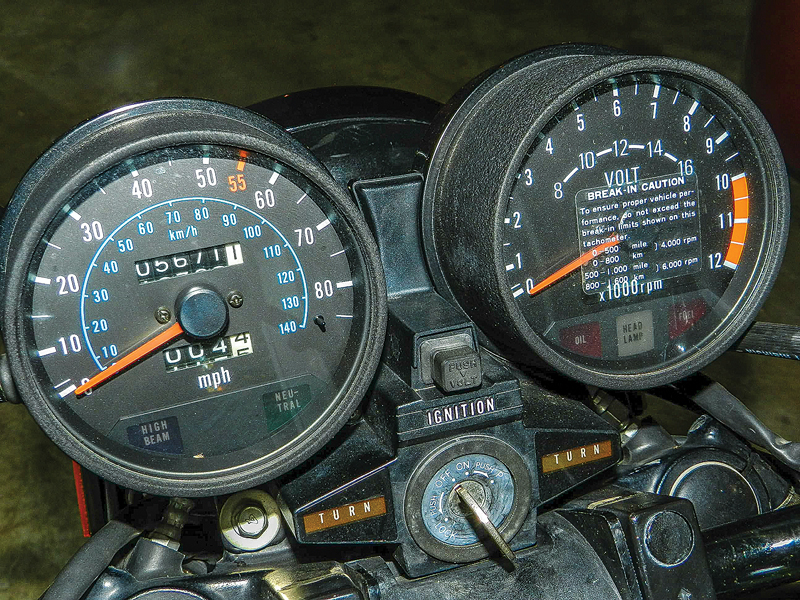
It being good economics to use the same engine in as many models as possible, Kawasaki had four models using the 738cc double-overhead camshaft in-line four, with the super-sporty GPz R1, the sporty 750E, the custom 750H LTD and the super-custom 750N Spectre. Curiously, the Spectre engine was the same as that on the GPz, rated at some 80 horsepower, while the 750E and the LTD had about five fewer ponies. The Spectre would be a performance custom, intended to challenge the Harley Shovelheads.
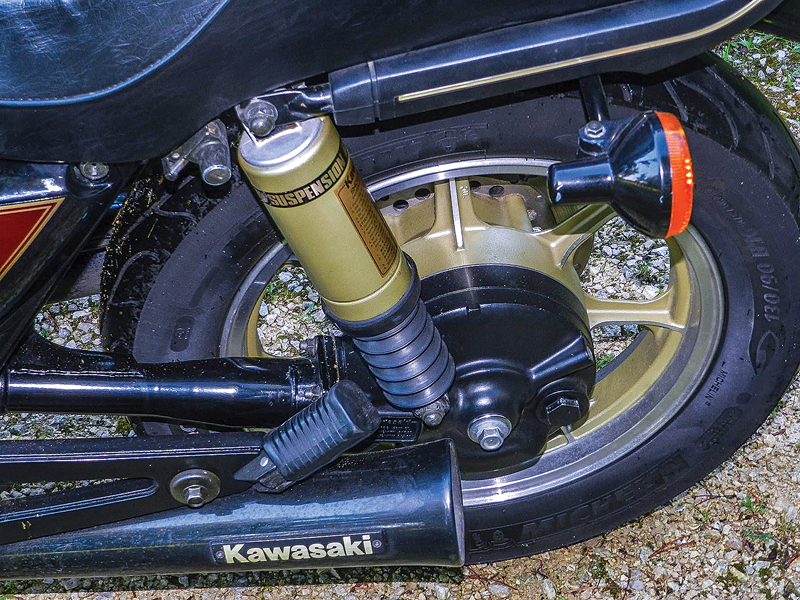
The major mechanical change in the Spectre was in the drivetrain—a shaft put the power from the five-speed transmission to the rear wheel, as opposed to the LTD’s chain. The
major advantage of a shaft-driven rear wheel is that maintenance all but disappears. Back in the early 1960s, the Japanese realized that there was a whole new American market of riders who were not thrilled with the idea of doing much work on the bikes they rode—they’d rather put in the key, push the button and go. And occasionally fill it up with gas.
The Yanks also wanted comfort, and large, soft saddles were bolted on. On the Spectre the saddle was relatively comfy, while the ergonomics were not. The seat/handlebar/footpeg arrangement was such that a rider would want to get off and have a stretch every hour or so.
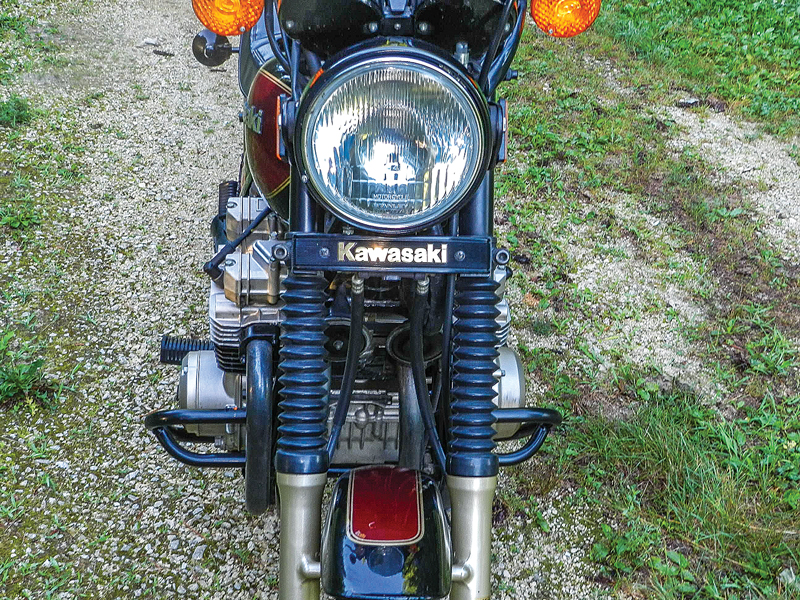
Comfort was also built into the chassis, with the new shaft drive allowing the whole engine/transmission unit to be rubber mounted inside the full-cradle frame, though a mild buzz could be felt at higher rpm. Since maximum torque came on at 6,000 rpm, though, there was no need to go up to the 9,500 redline.
The front fork had 36mm tubes, more than 6 inches of travel and rubber gaiters—very un-custom. And the fork was air-assisted, with a single fitting going to both legs. The hot-rod riders found that the fork was a bit skinny for bouncing along a rough road, but fine for urban pavement. The rear Kayaba twin-shock suspension also had air-adjustability, conveniently done by lifting the flip-up saddle. The shock absorbers also had adjustable damping, with four different positions, prompting many discussions and arguments about the proper combination. In accordance with the styling, the upper spring covers on the shocks were anodized gold. However, rubber gaiters at the bottom, again as uncool as could be imagined, covered the springs.
Rake and trail had been altered over the standard KZ, along with a considerably longer—by 2.5 inches—58.4-inch wheelbase. This did add a slight increase in stability in a straight line, but caused it to lack the quick-cornering agility of the original. No mind, as the designers felt the buyers would be intent on city streets rather than winding roads. The shiniest objects on the Spectre were the three stainless steel discs that provided excellent braking.
Wheels were certainly not intended for the road-racing crowd, with a 19-incher in the front, 16 at the back. But good acceleration, intended for stoplight drags, was very useful to have. At a strip, without a police car around the corner, a good rider could exceed 100 mph in 12.5 seconds. This is why it had the GPz engine, to impress the wheelie guys.
Talk of the town was the Spectre. Unfortunately, it appeared just as our economy descended into a serious recession; by the end of 1982 more than 10 percent of American workers were unemployed. To give a more motorcycle view of what was happening at that time, in 1980 Kawasaki had 30 different models on the showroom floor; in 1984 there were less than a dozen. Then in ’85 it introduced the Vulcan V-twin, understanding that V-twins were at the heart of custom design.








I recently purchased a 1982 KZ 750 in running condition . It could use a paint job, but other than that it’s a decent bike
I have all three spectres and they are slightly modified. I enjoy ridding them especially the 550 which spots a 6 speed tranny. Wishing Kawasaki would bring them back in modern and limited run edition.
My wife father passed away 1yr ago we didn’t know about a barm and in it under a army tarp set the 1983 KAWASAKI KZ550F1 SPECTRE it been there 30 yrs, The SPECTRE has 1500 miles on it so i’m restoring in for my wife
I bought a 1982 kz75o Spectre for five haundred dollars with six thousand original miles on it perfect paint job I cleaned out the rats nest in the air box and got it running after sitting in a garage for six years and now I ride it every day and doing a 100 plus it handles like a glove.
I bought a 1983 750 Spectre used in 1995 from the original owner with 7000 miles. It had the original tires on it and was basically still looking and running brand new. It was listed in the newspaper classifieds for $1450. Of course, when I pulled up to the house and the bike was sitting in the driveway looking all shiny, I immediately wanted to purchase it. After a quick 5-minute test ride around the block to make sure all the gears worked, I asked the owner of they would take $1200 and they said if you have cash now yes. I had that bike for 7 years and it was the smoothest bike and had plenty of power. It looked great and I really enjoyed riding it on the weekends.